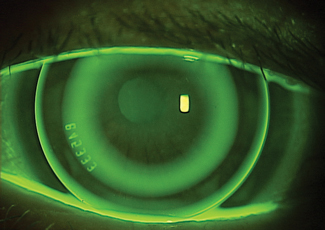 |
Myopic parents may need to take a more proactive role when deciding on myopia treatment for their children if their kids are going to benefit from ortho-K, study finds. Photo: Robert Ensley, OD, and Heidi Miller, OD. Click image to enlarge. |
Myopia management has continuously been on the rise and on the radar of optometrists. The option of orthokeratology lenses (ortho-K) has proven effective for pediatric patients at high risk of developing high myopia, but lags behind some other options because it’s less user-friendly. In one new study appearing in Eye, researchers in Shanghai sought to investigate the modality’s rate of usage among children and identify setbacks to success. They determined that health education and follow-ups should be strengthened to ensure the quality of this modality’s application.
Elementary and middle school children were enrolled across 104 schools. Of the total 72,920 children included, 32,259 were deemed eligible to use ortho-K. However, this option was observed to be used by only 1,021 participants, making up 1.4% of the total population and 3.1% of the potential eligible population.
Ortho-K use was positively correlated with age, BMI, age at initiation of refractive correction and presence of parental myopia. Sleeping less than or equal to six hours per night and a correction target of less than or equal to -3.00D were both factors contributing to unsatisfactory vision.
The low percentage of the population using these lenses here is reflective of previous research. The authors posit this relatively low use rate in myopic populations has been due to the strict adherence, regular follow-ups and adequate medical conditions needed to properly use ortho-K. They made note of these factors on top of adverse effects seen likely related to corneal hypoxia caused during sleep.
The authors report that junior high school students comprised the largest proportion of children using ortho-K, followed by elementary school students. Nevertheless, early refractive correction through use of these lenses is necessary as early age of myopia onset correlated with higher myopia.
Interestingly, the researchers found children with obesity less likely to wear ortho-K than those with a healthy BMI. This correlation is speculated to be due to many factors, such as less need to be lens-free during the day, as childhood obesity is related to less physical activity.
Unsatisfactory vision, as associated with higher correction target, may come from the limited deformation of the eye. The same observation with inadequate sleep is posed to be due to insufficient sleep time to cause said deformation, or flattening, of the cornea.
While this study provided a backdrop to estimate pediatric ortho-K use, the treatment could be expanded upon. To do so effectively, the authors proposed in their paper, “Ortho-K lenses should be used more specifically for children who meet the indications or have the need to take off glasses during daytime. To ensure a better therapeutic effect and reduce the risk of adverse reactions, practitioners should conduct more rigorous examination of indications and perform detailed examinations and inquiries during follow-ups in clinical practice, as well as adequately educate the children and their guardians.”
“Ortho-K lenses were an effective method for myopia control, but for reasons related to safety and efficacy, examinations, health education and clinical follow-up of children who use these lenses must be strengthened,” they concluded.
Zhao W, Wang J, Chen J, et al. The rate of orthokeratology lens use and associated factors in 33,280 children and adolescents with myopia: a cross-sectional study from Shanghai. Eye. April 12, 2023. [Epub ahead of print]. |


